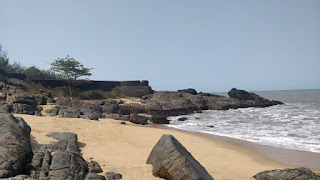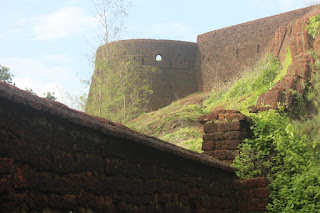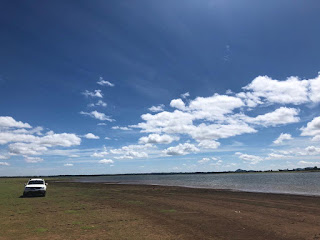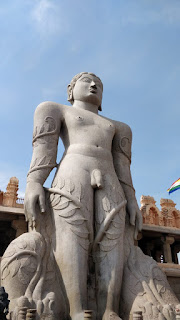This small village is a jain pilgrim place located between the two rocky hills Vindhyagiri and Chandragiri in Hassan district of Karnataka. It is an important jain pilgrimage and religious centre in South India. The hill is filled with a lot of inscriptions. The authorities have tried to protect the inscriptions in the surface by placing glasses around the inscriptions and providing a translation of the inscription. But they have started to break and needs repair.
Vindhyagiri - Gommateshwara: Shravanabelagola known as Gommatapura & Dakshina Kashi in inscriptions picturesquely set in between the two rocky hills Vindhyagiri and Chandragiri (locally called as Doddabetta and Chikkabetta respectively), derives its name from the splendid tank in the middle of the town referred to as the Velagola or Dhavala Sarovara is an important holy place for the Jains even today.
What attracted me to this place is the colossal statue of Bhagavan Bahubali Gommateshwara. This standing statue is the tallest monolithic stone sculpture in the world. And all this is surrounded by swaying coconut trees and natural water bodies. The view is amazing once you are at the top of the hill. One can observe the other hill from here and the green water tank between them.
We first visited Vindhyagiri, the hill which hosts the colossal Bahubali. The climb is steep with guard rails and has around 600 steps. You are not allowed to wear your shoes when you climb. And as the surface gets hotter as the sun rises its difficult to walk. One can buy socks for twenty rupees at the foothill. The beginning of the steps is started with a simple arch.
 |
| Archway |
Sri Parshwanatha jaruguppe temple is found towards your left at the very beginning of the ascend. Next as we climb up one can find a small gopura above the mid doorway. On both sides of this doorway, there is a big wall constructed out of stone blocks.
 |
| View of Chandragiri from Vindhyagiri |
After you enter the compound the first structure you notice is the Odegallu Basadi. This structure is built on an elevated stone platform. Might be it was done to built the structure on a plain surface. There are three sanctums sanctorum in this temple. In this temple we find seated statues of Adinatha tirthankara, Shantinatha tirthankara and the Neminatha tirthankara. We felt that it should have been a difficult task to carve statues without dress and differentiate each person from the other. We were still able to feel the difference with broad shoulders and a flat tummy. The platform which supports this structure is supported by slanted stone pillars to keep the whole structure in place.
Odegal Basti: The Odegal Basti is so called because of the stone props against its basement. It is the only triple shrine temple at Shravanabelagola. Built of granite blocks, it is impressive for the commanding position it occupies. All the pillars in the main hall are circular in shape and the outer walls are very simple. In the three sanctums are beautiful images of Thirthankaras carved in schist. The temple is datable to 14th century AD. In literary works the temple is known as Tirkuta Basadi.
 |
| Odegallu Basadi |
 |
| Odegallu Basadi |
Next on the path to the top is the Tyagada Kambha. This is a small structure supported by four pillars and a small mandapa built with stone and mortar at the top. This structure houses a beautifully carved cylindrical pillar with great workmanship.
Tyagada Kamba: This small, open, pavillion, with an upper storey is historically important. In the center of the pavilion is an elaborately carved pillar which is unmatched in artistic beauty. It was probably erected in the late 10th century. It is believed that minister Chavundaraya distributed gifts to the needy and the deserving from here. Another view is that he renounced from here all his worldly possessions including his life. the simple scroll designs, elegant workmanship, and bold lines, bring out the best of the Ganga workmanship. The original inscription at the base of was erected in about 1200 AD by Heggade Kanna. This Heggade installed the Yaksha image on top of this pillar, and got a record engraved at its pedestal. Some 500 years later, an upper mantapa was built in brick and mortar.

Next enroute is the Gajalaxmi doorway. The image of goddess Gajalakshmi seated on a lotus is found above the lintel of the doorway. On both sides of this Lakshmi idol, we find the carvings of elephants holdings a pot in their trunk, which appears as though the elephants are sprinkling the sacred water on goddess Lakshmi. On either sides of the elephants we find enchanting carvings of Makara the mythical animals and the Lions.
There is big boulder to the left side of the doorway with delicate carvings of jain saints and an inscription. There are two more doorways with beautiful pillars and carvings. After you climb this couple of steps you reach the last compound of the temple. Bahubali is visible from here above the compound wall.
Inside the compound is the Siddhara basadi with two relic pillars and the Gullekayi Ajji mantapa. The Gullekayi Ajji mantapa hosts the 5 foot tall Gullekayi Ajji statue. This statue is facing the Gommateshwara statue and is carved with rich ornamentation, representing the typical sculptures of the Ganga period. The image of the Gullekayi Ajji wears a blouse and a pleated saree.
Gullekayi Ajji Mantapa: An image of immense legendary interest is found in this mantapa. Its open ground floor consists of five pillars, an inscription and an image of the old lady. The upper floor enshrines a Yaksa image. The large central pillar was cut out of a boulder in the 12th century. An inscription at its base names it as "Manasthambha". The pillar and the Yaksha image were caused to have been made by minister Baladeva of early 12th century. The inscription column was placed against the central pillar in 1422 AD. by Irugappa Dandanaya. It mentions the gifts made by this general to Gommata.
 |
| Gullekayi Ajji |
The main Gommateshwara statue is enclosed within a walkway. The doorway to this courtyard has two magnificent door keepers. In the courtyard are the statues of a lot of other jain saints.
 |
| Door keeper |
And the final attraction of the temple is the colossal Gommateshwara statue. It is a nude statue in meditative mood. The eyes of the statue is carved in such a way that it appears like half opened and looking beyond this world with detachment. The statue symbolises Bahubali who stood in standing posture in meditation continuously for one year without food, on whom the anthills grew by the side and serpents made it as their adobe.
Every 12 years the statue is anointed in a great function called Mahamastakabhisheka. The last function happened in 2018 which I had missed and the next function will happen in 2030.






















































